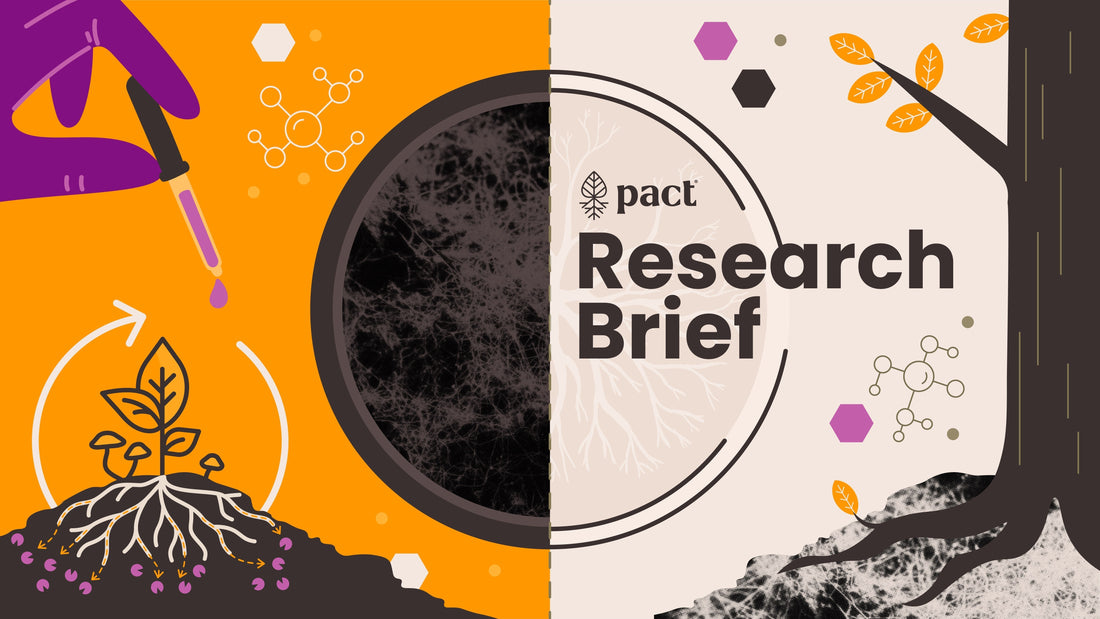
Other Applications For Stropharia and Mycoremediation
Share
Introduction
Bioremediation is an emerging field that involves using biologically-based treatments to restore soils and waterways damaged by contaminants. According to Bioremediation for Environmental Sustainability, a recently published textbook on the topic, it has been established as “efficient, economical, versatile, and environmentally eco-friendly” (Kuppan et al. 2024).
“Fungi-mediated bioremediation, or mycoremediation, has been studied in both terrestrial and aquatic habitats. In recent years, detoxification of contaminated sites by the application of one or more species of fungi as natural agents has become a widely used and effective tool for environmental remediation” (Akhtar 2020).
Compared to other organisms, fungi can tolerate high levels of pollutants, rapidly converting them into other bioavailable nutrients. They can tolerate extreme environments, sub-optimal conditions, and have extra-cellular enzymes that, while specialized for breaking down organic matter like wood and plant debris, are also highly adept at breaking down wide ranges of contaminants. Let’s look at a few examples of how fungi are being applied to common environmental challenges.
Agriculture & Pesticides
There’s no denying the increase in pesticide use particularly with food production is having many negative impacts on ecosystems and human populations alike. One of the major impacts is the increasing loss of biodiversity, another is the contamination and degradation of soils. According to a meta-analysis from Catia Venancio from the University of Aviero in Portugal, “Agricultural practices involving pesticides have been identified as the main factor in soil degradation, with approximately 60% of soil already flagged as degraded. However, this figure is set to reach 90% by 2050” (Cherlet 2018).
White rot fungi like those in the Stropharia genus have been studied for some time and show significant promise. For example, Stropharia rugosoannulata can increase biodiversity. Fungal hyphal networks serve as microhabitats (Hoosein et al. 2023), offering substrate for colonization by smaller fungi and bacteria. This promotes microbial biodiversity by creating a mosaic of micro-environments with varying levels of moisture, nutrients, and protection within the soil (Wagg et al. 2019).
S. rugosoannulata can also break down harmful pollutants such as hydrocarbons found in fossil fuels (Steffen et al. 2002), pharmaceuticals (Castellet-Rovira et al. 2017), E. coli (Taylor et al. 2015), and other toxic chemicals (Valentín et al. 2013), helping to clean up contaminated environments.
Additionally, Stropharia fungi can form associations with plant roots, benefiting plants (Bender 2022) by suppressing soil pathogens and outcompeting harmful fungi. From an agricultural and permaculture perspective, Stropharia rugosoannulata is often cultivated deliberately for its dual role as a food source and a natural enhancer of soil health (Gong 2018). This makes Stropharia fungi not only vital contributors to natural ecosystems, but also valuable allies in sustainable land management.
Forest Fire Remediation
Forest Fires can have devastating effects on soil systems and plant-life. They can reduce biodiversity, nutrient cycling processes, increase the risk of soil erosion, impeding ecosystem recovery. In addition, they create a huge loss of surface level biomass, coupled with a significant increase in recalcitrant organic matter from heating and burning.
Rot fungi, like the Saptroprophs discussed extensively in our research briefs, offer a promising solution. They initiate decomposition, unlocking nutrients for other organisms. They are willing initiators of a process that other organisms struggle with in less than ideal conditions.
Multiple studies have shown Saprotrophic fungi like Pyronema domesticum successfully colonizing and degrading charcoal and ash into less toxic, more bioavailable compounds that can be readily used by other organisms (Fischer 2021)(Filialuna 2021).
The role of fungi in fire remediation isn’t limited to decomposition, nutrient cycling and biodiversity support. Areas affected by fires generally face the same challenges as those affected by mining - massive destabilization of soil that makes it prone to erosion and limits its capacity to retain water.
As discussed above, fungi’s web-like mycelial network literally binds or aggregates soil together, creating microhabitats (Hoosein et al. 2023) and actual spaces for colonization by other organisms. This promotes microbial biodiversity through micro-environments with different levels of moisture, nutrients, and protection within the soil (Wagg et al. 2019).
Water Contamination
Waterway contamination is another byproduct of industrialization, outdoor recreation and other human activities. Mycofiltration, using fungi to filter and clean contaminated water, has shown tremendous promise across a number of applications and studies. Certain fungi work by trapping, breaking down and digesting environmental pollutants like coliform bacteria (E. coli), heavy metals, industrial pollutants and more. Fungi offer a potentially low-cost, environmentally friendly solution.
- The EPA funded work by Paul Stamets to investigate filtering out E. coli from water runoff after a rain storm (Stamets, 2013).
- Others have looked at mycelium as a means to reduce pathogens from wastewater lagoons. Researchers at the University of New Mexico, together with the city of Albuquerque, looked at using floating filters using oyster mushrooms. They found that the filters reduced surface level E. coli reliably, week after week (Martinez, 2016).
- The Dungeness watershed built a wetland to treat cow manure and incorporated a layer of mycelium with wood-like supplements to help it grow and the fungi (a trio of Pleurotus ostreatus, Pleurotus ulmarius, and Stropharia rugosoannulata) helped to consistently remove E. coli.
Conclusion
Bioremediation, and particularly mycoremediation, demonstrates the potential of fungi as natural agents of ecological restoration. Their tolerance for pollutants and ability to transform them into nutrients make them useful in addressing a wide range of environmental challenges. From reversing pesticide-induced soil degradation and fostering agricultural biodiversity with species like Stropharia rugosoannulata, to revitalizing fire-damaged forests via saprotrophic fungi such as Pyronema domesticum, fungi contribute to both immediate detoxification and long-term ecosystem resilience.
Furthermore, applications in mycofiltration—such as the successful removal of E. coli and other contaminants from waterways—highlight their promise as scalable, sustainable solutions for water quality improvement. As research continues, the integration of fungi into soil, water, and land management strategies offers a compelling pathway toward restoring balance in natural systems.
Bibliography
-
Akhtar N, Mannan MA. Mycoremediation: Expunging environmental pollutants. Biotechnology Reports. 2020;26:00452. DOI: 10.1016/j.btre.2020.e00452 - LINK
-
Cherlet, M.; Hutchinson, C.; Reynolds, J.; Sommer, H.; Graham, V.M. World Atlas of Desertification, 3rd ed.; Publications Office of the European Union: Luxembourg, 2018; p. 248. - LINK
-
Daâssi, D., Bouassida, M., Almaghrabi, F., & Chamkha, M. (2025). Mycoremediation: An Innovative and Sustainable Approach. IntechOpen. doi: 10.5772/intechopen.1009012 - LINK
-
Filialuna, O.; Cripps, C. Evidence that pyrophilous fungi aggregate soil after forest fire. For. Ecol. Manag. 2021, 498, 119579. - LINK
-
Fischer, M.S.; Stark, F.G.; Berry, T.D.; Zeba, N.; Whitman, T.; Traxler, M.F. Pyrolyzed substrates induce aromatic compound metabolism in the post-fire fungus, Pyronema domesticum. Front. Microbiol. 2021, 12, 729289. - LINK
-
Hoosein S, Neuenkamp L, Trivedi P, Paschke MW. 2023. AM fungal-bacterial relationships: what can they tell us about ecosystem sustainability and soil functioning? Front Fungal Biol. 4:1141963. doi:10.3389/ffunb.2023.1141963. - LINK
-
Kuppan N, Padman M, Mahadeva M, Srinivasan S, Devarajan R. A comprehensive review of sustainable bioremediation techniques: Eco friendly solutions for waste and pollution management. Waste Management Bulletin. 2024;2(3):154-171. DOI: 10.1016/j.wmb.2024.07.005 - LINK
-
Martinez, Savannah E.. "E. Coli Removal by Pleurotus Ostreatus Mycofilter in Simulated Wet Environmental Pond." (2016) - LINK
-
Paul Stamets, Marc Beutel, PhD., Alex Taylor, Alicia Flatt, Morgan Wolff, Katie Brownson. Mycofiltration Biotechnology for Pathogen Management. Fungi Perfecti’s EPA SBIR Phase I Research Results. 2013. - LINK
-
Venâncio C. The Quirky Rot Fungi: Underexploited Potential for Soil Remediation and Rehabilitation. Applied Sciences. 2025; 15(3):1039. - LINK
- Wagg C, Schlaeppi K, Banerjee S, Kuramae EE, van der Heijden MGA. 2019. Fungal-bacterial diversity and microbiome complexity predict ecosystem functioning. Nat Commun. 10(1):4841. doi:10.1038/s41467-019-12798-y. - LINK
